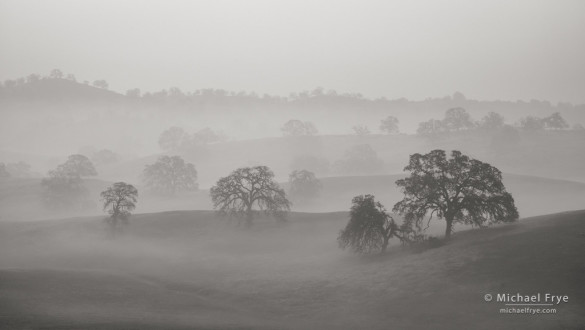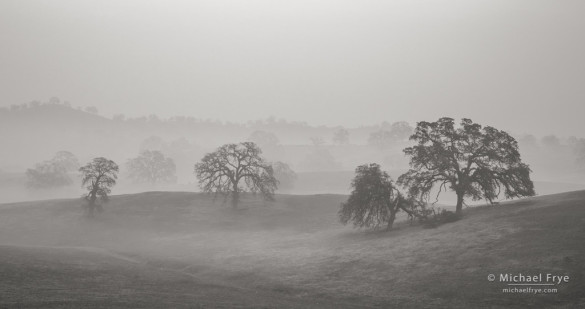Ansel Adams was quoted as saying, “A good photograph is knowing where to stand.” I’m sure he said this with tongue slightly in cheek – he knew full well that the art of photography was more complex than that. But he was trying to emphasize the importance of putting the camera in the right spot. Not just in the general vicinity, like “F/8 and be there,” but in exactly the right spot, and not an inch to the left, right, forward, back, up, or down.
Compare the two photographs shown here. In the photograph below, I moved left and right to place the three most prominent oaks between the trees behind them. But try as I might, I couldn’t completely separate the foreground and background trees, so I climbed further up the hillside behind me and made the image above. This higher camera position created better spacing and separation between the foreground and background oaks, and a composition I’m much happier with.
Choosing where to place the camera is the first – and maybe most important – decision you make when composing a photograph. This is such a vital topic that I wrote an in-depth article about it for the latest issue of Photograph Magazine. This issue of Photograph also includes an outstanding group of articles by John Paul Caponigro, Guy Tal, Martin Bailey, Piet Van den Eynde, David duChemin, and many others.
Normally Photograph Magazine is $8.00 Canadian, but since it’s just been launched you can get a 20% discount until midnight Pacific Time on April 22nd. There’s no code to enter – that’s just the price until that time.
I hope you enjoy the article, and the magazine!
— Michael Frye
P.S. Claudia and I are in Death Valley right now, preparing for an upcoming workshop. I’m having a wonderful time photographing this fantastic place, and I’ll post some images when I get a chance.
Did you like this article? Click here to subscribe to this blog and get every new post delivered right to your inbox!
Michael Frye is a professional photographer specializing in landscapes and nature. He is the author or principal photographer of The Photographer’s Guide to Yosemite, Yosemite Meditations, Yosemite Meditations for Women, Yosemite Meditations for Adventurers, and Digital Landscape Photography: In the Footsteps of Ansel Adams and the Great Masters. He has also written three eBooks: Light & Land: Landscapes in the Digital Darkroom, Exposure for Outdoor Photography, and Landscapes in Lightroom 5: The Essential Step-by-Step Guide. Michael has written numerous magazine articles on the art and technique of photography, and his images have been published in over thirty countries around the world. Michael has lived either in or near Yosemite National Park since 1983, currently residing just outside the park in Mariposa, California.











Muy bueno!
Thank you very much for these examples. I will be leading a group around town where I live with emphases on how to see fammilair scenes in a new light (No pun intended).
Fred
You do amazing work. As photographers, sometimes it’s difficult to fight the excitement and just jump in and start taking photos. It’s only when we take a moment and visualize what we are trying to convey that we know where to stand. That and of course not being satisfied with the couple shots before we nail it. Jasmine LI
Excellent post, Michael. Very important information. Strongly illustrates the value of taking time and being deliberate….And just think Ansel Adams and Philip Hyde, using film without being able to review it on the spot, were able to do all of what they did, which in this example would be: without being able to see the photograph “below” in the field to know to walk up the hill to make the photograph “above”… They used various techniques to see what the camera would see before even making an exposure. In my opinion, the photograph “above” is better not just because of the trees and separation, which are most important, but also because of more layers and the composition filling more of the screen and being more interesting, settled and harmonious.
Thanks David! I think digital cameras are more of an aid with exposure, or checking sharpness, than with composition. Yes, sometimes it helps to see that small image on the back of the camera, which gives you a different look at the composition, one that might prompt you to rethink it. But it’s certainly possible to make great compositions just seeing the image through an optical viewfinder, or framing it with a card and then setting up your view camera – as Ansel and Philip showed.
LIKE